STEM Profile Elements
- Lincoln STEM Elementary School - a STEM-themed neighborhood school
- Riverside STEM Academy - a program within a traditional middle school
- Administrative Considerations - insights and visioning from school and district administrators
Lincoln STEM Elementary School
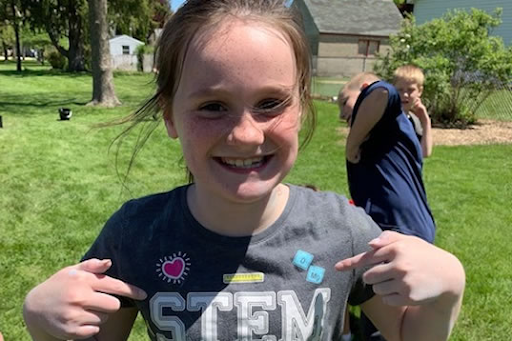 Lincoln STEM Elementary School is a STEM themed school located in the Watertown Unified School District, which is midway between Madison and Milwaukee. It has about 160 students, with 79% white, 12% hispanic, 6% black, and 3% other groups. In 2021, Dr. Kevin Anderson had the privilege of interviewing several of their teachers and leaders, and the below profile is an amalgamation of their responses, edited for clarity and brevity.
Lincoln STEM Elementary School is a STEM themed school located in the Watertown Unified School District, which is midway between Madison and Milwaukee. It has about 160 students, with 79% white, 12% hispanic, 6% black, and 3% other groups. In 2021, Dr. Kevin Anderson had the privilege of interviewing several of their teachers and leaders, and the below profile is an amalgamation of their responses, edited for clarity and brevity.
Be sure to also check out the Lincoln STEM virtual school tour, student showcase, and graduate profile.
School Profile Contents
What is our vision for this STEM work? What is our “why” for doing this work?
In 2016, our work started as we noticed a shift in student needs, such as social emotional learning (SEL), response to intervention ( RTI), and other academic support, along with a lag in engagement. We explored project-based learning (PBL) and began to develop some core beliefs about the importance of that type of student work. We saw a program on jobs of the future, which helped us realize our structures and strategies were dated, and that it was time for something more innovative.
Therefore, Watertown put together a STEM leadership team. We visited various sites and observed what they were doing and their philosophies, then started lots of teacher-led collaboration conversations on the side and on our own time. Many teacher-led meetings sitting in the basement refined our vision. We decided to use PBL as our framework with STEM as our subject matter, and our five pillars were born: “At Lincoln STEM it is our mission to engage, critically think, collaborate, innovate, and reflect through our learning.”
Our multiage design also built from our beliefs, with the K-1, 2-3, and 4-5 classrooms allowing for better relationships with students and families.
As we started trying new activities and projects, what we saw was exciting. We saw engagement! We saw decreases in challenging behaviors and increases in student use of 21st century skills like problem solving and behavior management. Throughout our efforts, as we implemented new programs and structures, such as bringing in local experts, growing school gardens, and allowing flexible seating, we continually came back to our five pillars to ensure alignment to our vision.
In order to inspire and engage our students, we emphasize different aspects to learning than we used to. We want them to be curious, asking questions about the world because they want to know, not because the answer might be on a test. We want them to see themselves making a difference in the community, thus we do food drives and donate our hydroponically grown food. It is also critical to build their identity and self-efficacy as a STEM professional, by seeing how what they do in class connects to their community and by experiencing job connections in their school work. Finally, we want them to develop a growth mindset, where failure is a key step in the process.
In the end, as noted in our framing documents, “Our work is to inspire our students, get them curious about the world and their passion for knowledge, where they are valued and respected through a PBL environment. We want our students to be confident, global citizens and prepared for those jobs that we don’t even know about yet.”
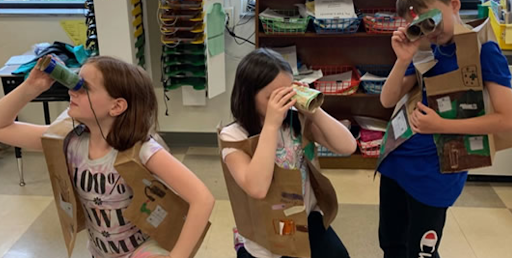 At Lincoln STEM, we prioritize a curriculum based on the idea of educating students in four specific disciplines — science, technology, engineering and mathematics — in an interdisciplinary and applied approach. Rather than teach the four disciplines as separate subjects, STEM integrates them into a cohesive learning paradigm based on real-world applications. There are still math and literacy blocks built into the schedule, but these skills are increasingly applied to real world interests and skills, and also include hands-on and project-based learning.
At Lincoln STEM, we prioritize a curriculum based on the idea of educating students in four specific disciplines — science, technology, engineering and mathematics — in an interdisciplinary and applied approach. Rather than teach the four disciplines as separate subjects, STEM integrates them into a cohesive learning paradigm based on real-world applications. There are still math and literacy blocks built into the schedule, but these skills are increasingly applied to real world interests and skills, and also include hands-on and project-based learning.
Another focus of the school is the development of Habits of Mind that reinforce key attitudes and lessons for lifelong learning like persistence, flexible thinking, and leadership. We focus on the Habits of Mind as a way to prepare students for an ever-changing workforce.
We use Project Lead the Way (PLTW) as our core STEM curriculum materials. Not only is it standards-aligned, but it also exposes students to current real-world problems and uses characters and situations that represent a diverse world. It supports hands-on, problem solving, flexible thinking, and collaboration skills. For example, in early 2020 we taught our biomedical sciences unit, “Infection Detection,” about a hypothetical case where viruses were spreading with a need to get them under control. It included an activity where students simulated viral spread with a UV-visible powder and found patient zero. It couldn’t have been better for a COVID world! We’ve talked about that experience in relation to washing our hands since.
Students have exposure to a wide range of technology. Our school has 1:1 technology which allows all students to have access to the materials and resources they need regardless of their economic status. Students engage with our makerspace, Glowforge, 3D printers, carving machines, laser engravers, outside gardens, hydroponics, iPads, and robotics! These tools engage students with real-world experiences in the classroom as well as families when they come to our school events.
We continually work to connect to parents and the community. Twice yearly, our students engage in student-led conferences in which they prepare a presentation from their Learner Profile/Data Notebook to present to their families. This allows them to take ownership of their learning and reflect on next steps.
In addition to inviting outside experts to our school, students also become the STEM experts. Students complete passion projects on topics of their choosing. We used inspiration from Google which allows their engineers up to 20% of their workday to be used on a project of their interest. This time allows students to further their knowledge on a topic of their choice, conduct research, and present to an audience. These projects are celebrated during our STEM community nights.
Who made the decision to emphasize STEM?
As mentioned above, we started rethinking our approaches to teaching in 2016 in a series of basement meetings. There was an increased interest in STEM across the district and with district leadership at the same time, so it really came together. Most of our initial efforts were teacher driven, in the interest of our students.
After a series of internal meetings and beginning work with PBL, our planning came together with district leadership. We developed a three-year implementation plan supported by our former Director of Instruction, Dave Vitale. The plan included setting the goals we wanted to move forward in a systematic manner. We tackled curriculum work with PLTW training and implementation in the first year along with the multi-age model. In the second year we added other technology and continued to explore what worked best. In the third year we pulled in further community partnerships, and moved outside in learning with field trips, the garden, and other opportunities, staying in line with the PLTW model. Dave Vitale and administrators helped with grants and a “What do you need?” and “How can I help?” approach throughout our efforts. Their answer was always yes, so we’re very lucky that way, especially with funding limitations. Local businesses, our hospital, and John Deere became partners. Once we were able to establish a vision with our school team and take that to the board, we were all in agreement to do it. It aligned with a district five year plan to increase literacy. Innovation and new methods were needed, and it came together to do it at once.
Community buy-in was critical! With it, we didn’t have a ton of roadblocks. We found it crucial to have buy-in from the administration and board to become a STEM school. Students also shared their perspective with the board in our approval process. Staff buy-in was also critical. It is a lot of extra work for staff beyond teaching the curriculum, so full commitment is necessary.
Currently, we think Lincoln STEM is unique in Wisconsin. We visited several other schools during our planning phase. Most in-depth STEM programs were charter schools or speciality schools within another school. Many schools only have a STEM block, where it’s a once a day set-up. We did not find other STEM themed public schools like ours.
Where is STEM/STEAM happening? What do school and schedule structures look like to make it work?
 STEM is embedded in every classroom in the school, and each teacher teaches multiple disciplines. There are still Math and Literacy blocks built into the schedule, but these skills are increasingly applied to real world interests and skills that our students possess. As an elementary school, we see the importance of strong readers, writers and thinkers, and we can meld district goals in those areas with what we’re doing. We have flexibility for integration. While at times we wish we had more flexibility, we know we need to support students with a strong foundation in core academics as well.
STEM is embedded in every classroom in the school, and each teacher teaches multiple disciplines. There are still Math and Literacy blocks built into the schedule, but these skills are increasingly applied to real world interests and skills that our students possess. As an elementary school, we see the importance of strong readers, writers and thinkers, and we can meld district goals in those areas with what we’re doing. We have flexibility for integration. While at times we wish we had more flexibility, we know we need to support students with a strong foundation in core academics as well.
We collaborate across grade-levels to attempt to align our STEM curriculum, as well as, other areas of instruction. The Watertown Unified School District (WUSD) provides all schools an hour and half of collaboration time every Wednesday with an early release of the students. We use this time to collaborate within our grade levels, with special education staff, across grade levels within our building, with our grade levels across the district, and with our K-12 STEM team. We also have monthly meetings of the Lincoln STEM Innovation Team to discuss our school progress towards varying goals, develop new ways to further our students’ learning, monitor technology experiences, and promote community engagement.
The Watertown Unified School District implemented a district/school leadership team that helps to monitor and develop our strategic planning process K-12. Our K-12 STEM vertical team meets quarterly to align our curriculum, goals, partnerships, and expectations for students.
How is equity centered in this work?
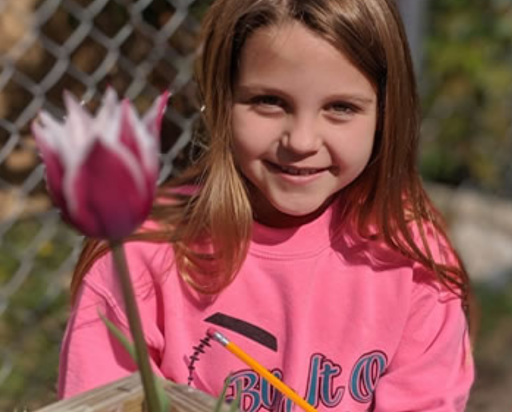 Because we’re not a charter school, students represent the general demographics of the area in relation to EL, special needs, etc. We don’t pick and choose. We felt this was very important, and we did not want to filter out anyone in this school to support equity in who comes to us. Currently, our district places students in the various schools as there are openings. Students are placed district-wide based on the following factors: individual school enrollment numbers, special education enrollment per building, neighborhood address, and parent request. Parents can request a specific school, and we have built a waitlist of students, but our district does not currently recruit based on subgroups and other demographics. We are continually promoting our school brand through our evening events, promotional videos, branding items, etc. Our goal is to mirror the school population of other schools in our district.
Because we’re not a charter school, students represent the general demographics of the area in relation to EL, special needs, etc. We don’t pick and choose. We felt this was very important, and we did not want to filter out anyone in this school to support equity in who comes to us. Currently, our district places students in the various schools as there are openings. Students are placed district-wide based on the following factors: individual school enrollment numbers, special education enrollment per building, neighborhood address, and parent request. Parents can request a specific school, and we have built a waitlist of students, but our district does not currently recruit based on subgroups and other demographics. We are continually promoting our school brand through our evening events, promotional videos, branding items, etc. Our goal is to mirror the school population of other schools in our district.
Every student has the opportunity to jump in as a STEM professional, engaging in workforce skills. Hands-on, project-based learning and passion projects allow them to engage in projects connected to their cultures and identities–things they know best and want to find out about. Multiple modalities and platforms across their learning supports all learners. Our district vision is “Excellence for All,” and we align our building and STEM goals to that. We want to give students opportunities they might not have in the technology they get to use and community partnerships that expose them to the broader world.
Additionally, our multiage grade structure allows for better meeting the needs of all students. Students above and below grade level can be shifted based on their needs, because there are a wider range of learners.
How are community and student voices involved? How are partnerships supporting this work?
We are at the stage in our implementation that we have begun to build community partnerships. Our most effective project is our school-wide garden and hydroponics project. We have raised donations from community businesses to support the materials needed to fund the project. We have in turn donated our harvest back to the community through our local food pantry, community family events, and for use in our curriculum for our student body.
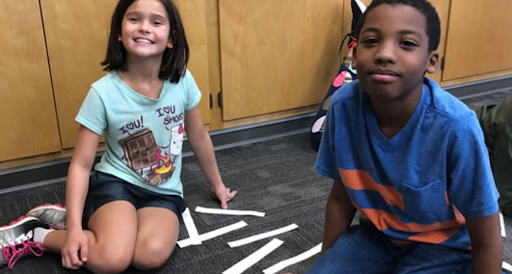 We have also received support around our Project Lead the Way curriculum through grant programs with John Deere and the Watertown Community Hospital.
We have also received support around our Project Lead the Way curriculum through grant programs with John Deere and the Watertown Community Hospital.
We have invited STEM experts to share about their various fields during a school-wide Career Day, brought experts in to support our PLTW modules, and have taken students off campus to visit local businesses in support of our STEM learning goals.
Additionally, students are able to connect their passion projects to jobs and topics in which they are interested. This project allows them the opportunity to interview local and state experts.
What does professional learning look like?
We have all received our initial training with Project Lead the Way (PLTW). We also have two district PLTW trainers that are available to provide support to staff members on an as-needed basis. We have done a lot of work on standard-aligned materials in all areas except for STEM. That is our goal in our next 5-year plan.
There currently is not an ongoing plan for professional development regarding specific STEM training; however, the district is supportive of providing staff with any training requests. We do not have STEM-focused professional development days on our calendars. A barrier is that most STEM training is out of state, increasing the cost beyond our current budget. We currently have a few staff members going to training and reporting back to the whole. At this point, we are also missing multi-age training and support.
We have our STEM equipment and materials, which we purchased through grant funding. The WUSD and our administrators utilize funding toward our program through the district-wide curriculum budget that encompasses all types of funding–STEM is not separate from that.
After using the DPI STEM reflection tool, looking at our district STEM plan, and utilizing our Lincoln STEM School Evaluation, we have noticed some areas in need of improvement. First of all, we feel the need for a clearer vision for our school. At this point, we feel as if our school is creating our own vision and goals, but we are not collaborating as closely as we could be with our district-wide STEM program and/or state STEM programs. We think it would be helpful to have a state goal for STEM schools which would then affect district-wide STEM goals, and, in turn, affect school-wide STEM goals and visions. Once we have a specific step-by-step plan, we would like to regularly meet with our district STEM team to evaluate our progress and decide on next steps to continue the growth of our program.
 We also feel like we need a continual STEM professional development plan. We received initial training in our PLTW curriculum and visited numerous existing STEM schools to observe and see what they were doing while we were creating our plan and vision, but there are limited options for ongoing professional development in the area of STEM. We would like trainings about how to better integrate STEM into our core subject areas, as well as, how to better utilize technology in our day-to-day instruction.
We also feel like we need a continual STEM professional development plan. We received initial training in our PLTW curriculum and visited numerous existing STEM schools to observe and see what they were doing while we were creating our plan and vision, but there are limited options for ongoing professional development in the area of STEM. We would like trainings about how to better integrate STEM into our core subject areas, as well as, how to better utilize technology in our day-to-day instruction.
As we discussed the need for continual professional development and technology integration, we ran into the barrier of finances. We need a clearer understanding of the allocation of funds for STEM programming and training within our school and district. Budget funds have never been something that has been transparent in our district, and that adds an extra challenge when it comes to setting goals as we are unclear of how far-reaching our goals can be.
After we figure out funding, we need to make a clearer plan for how we are going to utilize those funds for our students and staff. Having flexibility over the schedule and calendar for staff and students would be the next step. There will be STEM-specific training for staff which we may need time off for. There may also be STEM-specific learning opportunities for our students, and we will need flexibility in our schedules and curriculum planning to account for those things. In our current stage of planning, we have district-wide pacing guides for our core academic areas. Those pacing guides do not take into account our STEM curriculum, and we feel like they limit our ability to fully integrate STEM into our day. We would like to work with our district instructional coach to make a more STEM-focused pacing guide that still covers core areas of our curriculum but allows us to better integrate our hands-on STEM learning throughout the day in areas such as reading, writing, and math.
As we integrate STEM into our core curriculum areas, we would like to also extend our STEM learning into the related arts fields. Working with our related arts teachers and connecting our learning with their content areas is another way to further our students’ learning and understanding. We are hoping for our days to be truly interdisciplinary learning for our students.
Finally, as we continue to integrate STEM into our school day, we would also like to expand and build upon community partnerships. This allows students to take their learning from the classroom and connect it in real-world settings. This also gives them a vision for their future and can help to foster and develop a love of STEM careers.
How will the STEM program be evaluated?
Evaluation is a process. This year (2020-21), with less community connection due to COVID, we had time to reflect on what really makes them Lincoln STEM and what were add-ons that were not working. This year has also been a dismantling and remantling year - What’s our core and our five pillars? What do we want for our students and the school and how do we get back to that?
We figured out right away that whole staff collaboration was necessary, which happens weekly. Also meet in small teams weekly and have specific committees to maximize work and time. There’s never a moment that we’re not thinking about and reflecting on our practice or promoting with our community to share what our school is.
Thinking of evaluation (or reflection) on our work, we thought the DPI STEM Self-Reflection Tool helped us think about our programs in new ways.
Completed reflection document for Lincoln
We spent hours going through this tool and reflecting on our work. It wasn’t just a quick get it done, but it was every single box, talking about it and noting where we see ourselves, why we’d see ourselves there, and how we could score higher. We felt that it was necessary to do it as a full staff, because we’re all so invested and have had different experiences in our classroom and grade level. It was a great tool that forced us to have good conversations. It was only effective because we did it as a whole staff in relation to our vision.
For every section, we’d end up off on conversations about next steps and what we could do. We thought the mission and vision of the tool aligned with ours and where we’ve been and where we want to go. We appreciated the initial, beginning, and systemic categories, because we want to be systemic. We saw that we weren’t in many ways, which was difficult, as we always want to be better. We have big visions and goals and know we’re not there yet, but that’s part of the process. We did see it as attainable–what things could we put in place to move to the next section?
We saw how super necessary this tool is and appreciate it being done at the state level, as we can then we can align district goals and building goals. A challenge is that it’s harder to start at the building level, then going up to the administration to ask them to tweak something there.
One of the reflection sections focused on student pathways. Watertown has unique pathways for STEM. We have PLTW in regular high school, but then we also have charter pathways. Having multiple K-12 pathways is great, but aligning all of those has no easy answers. We saw that we could work on that and have clearer communication with families on options/pathways.
There were a couple places in the tool that could be tweaked for different grades, such as sections on course choices, internships, advisory committees, etc. We’d prefer to adjust it to our grade and note that there are school and district-wide tracks, with some that are specific to elementary or secondary.
Riverside STEM Academy
The Riverside STEM Academy is a program within Riverside Middle School in the Watertown Unified School District, which is located midway between Madison and Milwaukee. It focuses on personalized, project-based learning with STEM and socially connected themes, taking the place of the science, social studies, and English classes of the 100+ students who enroll in it. Students enroll in other courses in the middle school as usual. Demographics generally match the school more broadly, which is 67.5% white, 23.7% hispanic, 1.4% black, 0.9% Asian, and 6.5% multiple or other racial groups. In 2021, Dr. Kevin Anderson had the privilege of interviewing the Academy teachers, and the below profile is an amalgamation of their responses, edited for clarity and brevity. Notably, this profile is a snapshot from 2021, and the program has had to continue to evolve since that time.
School Profile Contents
What is our vision for this STEM/STEAM work? What is our “why” for doing this work?
We want authentic learning where students and their lives are at the center of everything they do! STEM is everywhere and will be in the forefront of society for quite some time, given the technological nature of society. It won’t burn out quickly.
What we were doing worked well enough, but it did not meet students’ needs as well as it could have. We wanted the students to be more engaged, and to be more passionate about teaching ourselves, so we began to change how we worked together. With the support of the administration we began to experiment with a class based on project-based learning.
Who made the decision to emphasize STEM? What is the history of the program?
It started as an idea by the 8th grade science teachers. We formed a semester-long project-based learning course in 2015-16 taught by us and counting as students’ science class. The principal was open to ideas for shifting student engagement and gave us encouragement to try it. In that first year, we threw it out to 8th graders and 21 signed up for it instead of the typical 8th grade science.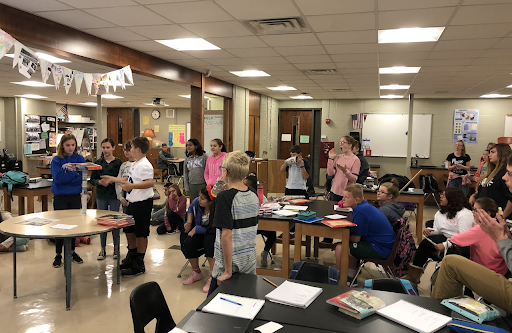
In 2016-17, we added social studies, which worked well as science and social studies were scheduled for one semester each or every other day at the middle school. Given this schedule, adding social studies made it possible to grow the program and make it more sustainable. Eighty students signed up in the second year, and we added two social studies teachers to the team. The social studies teachers originally were not quite as interested in the project-based and personalized learning vision; it took some experience for them to see how well it worked with students.
Our brainstorming could only take us so far. Before starting and during the first couple of years, we did multiple site visits, which helped form our vision and goals. The necessity of working within the bell schedule and staff schedules also constrained the possibilities from our grand vision. In the end, we feel that is an important lesson for other schools–that this type of work is possible within a traditional middle school schedule and structure. This possibility, however, was really due to fantastic administrative support. Our administrators let us actually experiment with this class, which became another notable learning experience, as we could have used more guardrails and guiding perspectives from administrators at times.
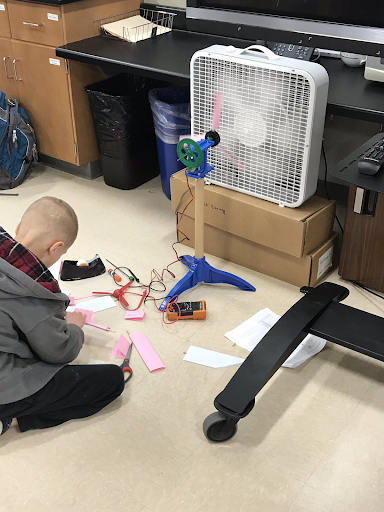 In 2017-18 the program expanded with a lot of student and family interest. We had 100 students with science and social studies, and we also made it a 7th and 8th grade multi-age group. The length of the program was still one class period, now with multiple sections.
In 2017-18 the program expanded with a lot of student and family interest. We had 100 students with science and social studies, and we also made it a 7th and 8th grade multi-age group. The length of the program was still one class period, now with multiple sections.
In 2018-19 we brought in an ELA specialist and sixth graders, while also scaling it back to 60 students to make sure it was done well. We opened up and connected two classrooms, plus had a third across the hall to use. Adding ELA meant that the program included two hours in the students’ schedules and was a game-changer for the pedagogy of projects-based learning. It was a hard shift for ELA to not blow up everything we had always done but to rethink it in a project-based framework.
In 2019-20, we built back up to 80 students and up to 108 in 2020-21, with the addition of a fourth teacher, who has an ELA background.
Thinking of who is making decisions and our history, it’s important to note that we have grown and sustained this program through three principals. All three have been supportive, which we attribute to good hiring and consistent district level leadership. Our Assistant Superintendent, Dave Vitale, has been around through the whole process and provided a steady vision. We appreciate that his focus has always been on what’s best for children and how to make that happen together.
The underlying goal is for students to engage in authentic projects based on their own identities and interests, which connect to essential learning in literacy, social studies, and science/engineering. We have core learning where all students engage in a particular project or elements of background understanding, but that learning is not an end in itself, instead supporting students in their own personalized journeys. Currently, mathematics or CTE teachers are not part of our team, but we do aim to integrate mathematics and career-focused learning as relevant for students.
Our website has a range of resources to further demonstrate the type of learning that happens at Riverside: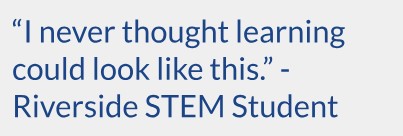
- A Student Video features the voices of students describing their learning at Riverside.
- The Project Overview details how we structure projects and infuse ELA.
While students often engage in individualized projects, there are also whole group learning opportunities. We have found that some background knowledge and skills need to be taught to all students together through common projects and experiences. Additionally, we have found that there are some high interest topics for students that align to the standards, so we have created several project templates to dial it up quickly for student reference. Currently, there are about 25-30 projects with scaffolds and ideas ready to go, which saves teachers and students time.
Where is STEM happening? What do school and schedule structures look like to make it work?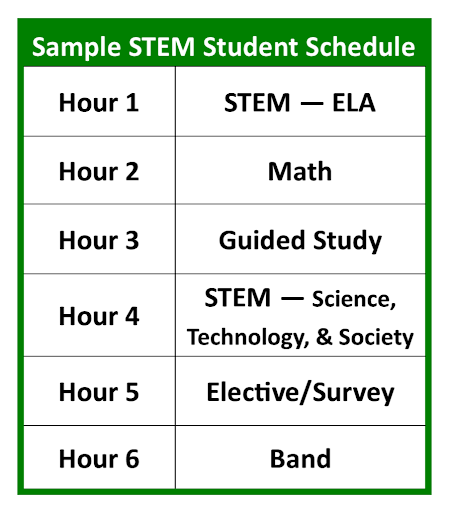
Here is a sample student schedule. “Hours” (our class periods) are about 70 minutes. In place of a daily ELA class and every other day science and social studies classes, students meet with grade 6-8 peer groups in our within-school STEM academy. Their mathematics and elective courses remain the same, with peers from the regular middle school. The STEM teachers have adjoining classrooms, with the walls taken down, so students can be team taught and supported in a collaborative, co-taught way.
Therefore, it is particularly important that the STEM academy teachers have a common collaborative planning hour daily.
How is equity centered in this work?
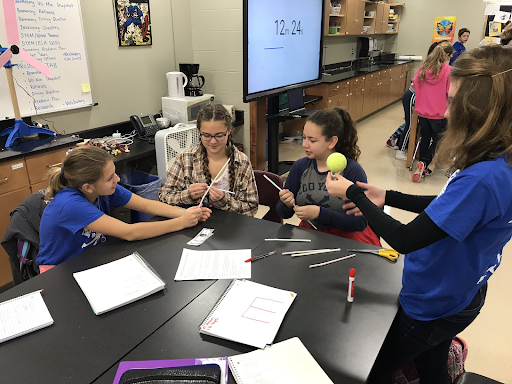 First, we make sure the demographics of the program match that of the broader middle school and district. We checked on that data, and it did match, which was somewhat of a surprise. It was not a perfect match, but very close. We keep tracking it to make sure that entry into the program is very accessible, that there are no barriers. All they have to do is check a box to say they are interested; it’s easy to remove them from that list later too. If there are more students who want to be in it than there are spaces, we hold a lottery. We also make sure that our guidance counselors share clear language and messages to students about the program. We share a clear message that we want students who are interested in leading their own learning.
First, we make sure the demographics of the program match that of the broader middle school and district. We checked on that data, and it did match, which was somewhat of a surprise. It was not a perfect match, but very close. We keep tracking it to make sure that entry into the program is very accessible, that there are no barriers. All they have to do is check a box to say they are interested; it’s easy to remove them from that list later too. If there are more students who want to be in it than there are spaces, we hold a lottery. We also make sure that our guidance counselors share clear language and messages to students about the program. We share a clear message that we want students who are interested in leading their own learning.
We feel that our classroom-level pedagogies and structures also support equitable learning. Students have more independence, with individual choices on timelines, methods, topics, and products. Students become more invested in meaningful and personal projects. With real-life self-pacing, teachers then have more time to provide additional, individualized supports and resources. Students have ownership of their learning and advocate for what structures and learning work best for them. While we have a significant focus on what individuals formatively need, we recognize that students learn well in group conversations and collaboration, so that type of work also happens.
How are community and student voices involved? How are partnerships supporting this work?
There is ongoing feedback from students and families. We constantly talk to students about how they are doing and what works for them or does not. Parents, as needed, end up as part of those conversations. We also have more formal parent-teacher conferences.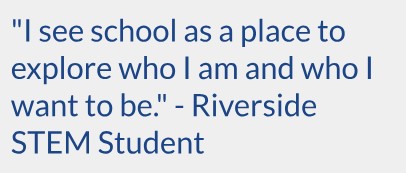
Several pre-structured project templates include external partners and resources. With ongoing work we have built up those relationships. It is hard to find the time to make those connections. We do not have systems for broader community input for our program at this time.
What does professional learning look like?
Professional learning has been critical in figuring out how to make this new program work. Site visits, especially in the beginning, were critical for our learning. Our ongoing, daily team collaboration time for an hour also makes this work. We constantly learn from each other as we plan how to best support each student.
Time. Time is the most valuable resource. With 108 students and authentic project support, we are always wishing for more time. Students work hard and gradually we are revising scaffolds, processes, and resources to support them even better in their learning.
How will the STEM program be evaluated?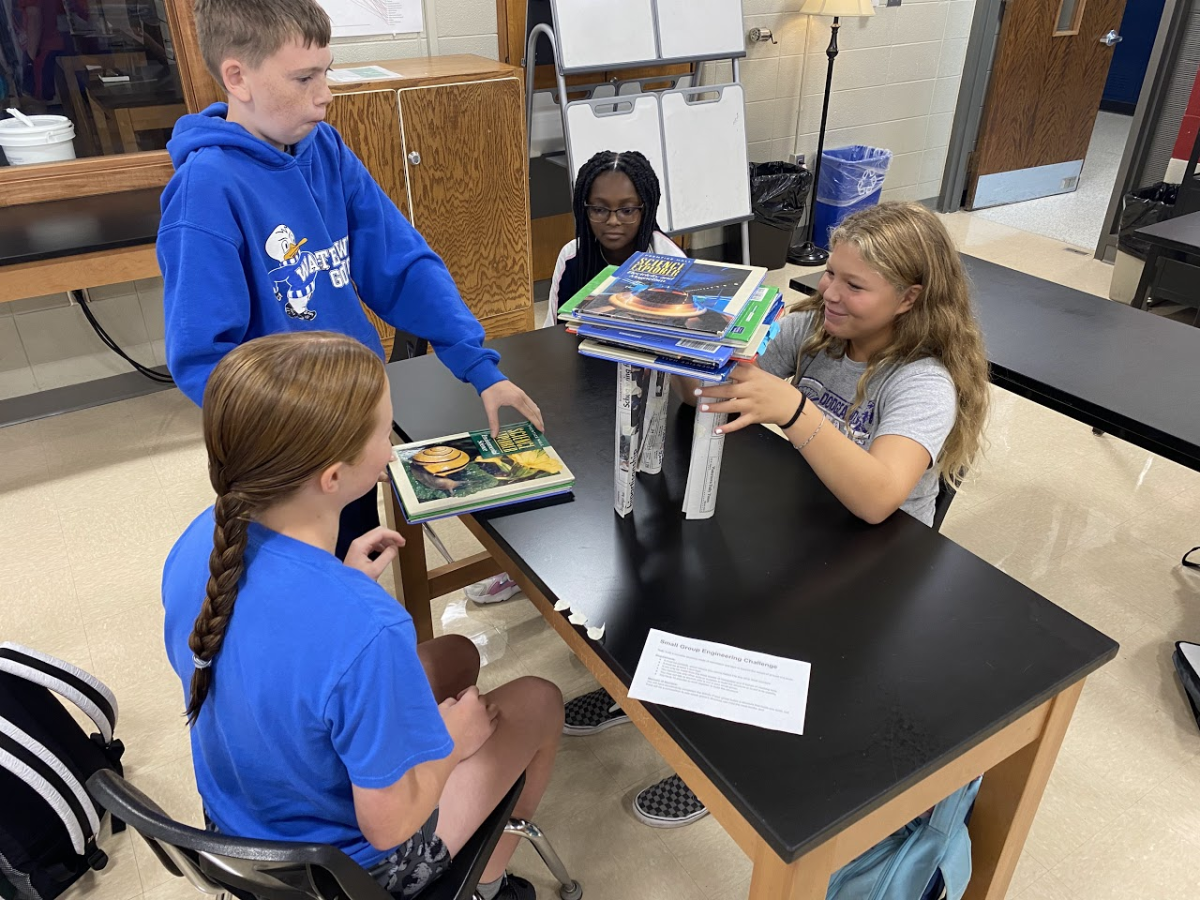
To date our reflection has been organic and constant. We are always asking the students how the structures and processes are working for them, and we are observing what is working and what is not. It’s an iterative process, like engineering.
Based on work with students, we continue to tweak what we are doing. For example, we use self-pacing of projects, but middle school students are not good at managing their time. We have to build in additional tools and supports, like daily calendars and goals, even for each hour to be clear on what they’re working on. The program is not a free-for-all. Our work on short and long-term goals, student check-ins, and family communication evolved over time and were not there on day one. It also develops based on the needs of particular students, as what helps one student often helps most of them).
There are more quantitative components to our evaluation. We look at STAR and other testing results to determine particular standards to emphasize. We have done surveys with families. These formal tools combine with informal tools to inform our work with students, but we don’t need a survey to know if a particular student is struggling. We are constantly talking about their needs together. The students receive immediate and constant feedback when they need it and they’re ready for it.
As another data point, we helped create a video to highlight learning in our program. The whole video uses students’ words and phrases. It authentically shows how much they value the learning they are experiencing.
Thinking of reflecting on our work, we have some feedback on the Wisconsin DPI STEM Self-Reflection Tool.
While there were some categories that nudged our thinking forward, there were many that required larger systems conversations with administration. We quickly saw that we were not even on the chart yet in some areas. We are just a small program within a school, not a full-scale district way of doing things. Therefore, we ended up in the “initial” column in much of our work, but we did not feel that level truly reflected the advanced and thoughtful work we’re doing. This tool is likely better for a team with administrators rather than classroom teachers.
We did, however, realize that there are some things we could work on by reflecting on the tool. It provided space to think about where we’re at and our long-term goals. One goal is to get something on paper in terms of a vision, goals, and mission. That’s a next step for us. Sustainability is also something we want to consider. We liked a lot of the language and vision spelled out in the tool. It was a nice mental inventory to consider what we might need to do. The ideas in the “systemic” column are things we’d like to strive toward, though as classroom teachers we don’t feel it’s our role to go there. As we’ve noted, we don’t have the time to do all these things.
Thinking of our wider district programming, it would be nice to talk more systematically, such as with Lincoln, our STEM elementary school. We don’t need to be completely uniform K-8, but we want to support these students in a coherent path. This tool could also apply to other classes and programs across the middle school; there are strengths in PBL-based learning for all students. In all of this work, we emphasize that you can’t wait for things to be perfect; it’s an organic building process, and that’s okay.
Administrative Considerations
Watertown Unified School District is a part suburban and part rural district midway between Madison and Milwaukee. It has about 3200 students, with 69.9% white, 21.7% hispanic, 2.3% black, 0.9% Asian, and 5.2% other groups. In 2021, Kevin Anderson had the privilege of communicating with Dave Vitale, former Director of Instruction, and Mark Getz, Principal of Lincoln STEM. The below profile is an amalgamation of their responses, edited for clarity and brevity.
District Profile Contents
What is our vision for this STEM/STEAM work? What is our “why” for doing this work?
From an administrative standpoint, STEM is the lens through which we foster 21st century skills. It gives parents and stakeholders a sense of "what happens at Lincoln or Riverside" when we say STEM education. What we're really trying to do is build learning environments that foster engagement, agency, and authenticity.
STEAM is sort of implied in our STEM programming in that we really believe it's about the process rather than what you call it. In other words, artistic and scientific processes hold many similarities and it's the iterative process that we uphold as more important the wedging a particular content area into the school's profile or name.
 This STEM postcard highlighting Lincoln and Riverside is shared with our families and community and this Lincoln graduate profile poster highlights the vision of the program/school. The profile posters are displayed throughout the building and in our Central Office.
This STEM postcard highlighting Lincoln and Riverside is shared with our families and community and this Lincoln graduate profile poster highlights the vision of the program/school. The profile posters are displayed throughout the building and in our Central Office.
Of course, STEM doesn’t only happen at Lincoln STEM and Riverside STEM Academy. The project-based and personalized learning seen at Endeavor Charter School (personalized and eCampus Academy Charter School are examples of continuing those same themes from the K-8 STEM programs. Our high school also has robust STEM efforts through the Career and Tchnical Education program. Further, we see STEM projects happening in various classrooms and subjects throughout K-12, even where they’re not part of a themed program.
What does STEM/STEAM look like?
With our STEM programming, the goal is to not make it episodic, so the idea of where it takes place is not in a STEM "class" or after school activity, although those are potential enhancements. As noted in our documentation, STEM reflects real-world skills needed in society and connects to the interests of our students across the S, T, E, and M subject areas. We hope those important experiences will be infused throughout learning.
It was a challenge for these educators at times to rethink everything without many examples to compare it to that quite matched what they were doing. The result feels very authentic and has created a space where students and educators can truly take risks, which is critical. The STEM focus is on what’s best for kids.
Currently (in 2021), there is nothing specific on paper called a “vision, goals, and mission,” though the five pillars and graduate profile for Lincoln basically serve that purpose. That’s a next step for us and will help with staying power.
Who made the decision to emphasize STEM?
There were many philosophical discussions among educators and administrators. Those discussions were super important in building the vision. Dave Vitale, in particular, helped push that vision forward with principals and the district in general. There was a lot of support from administrators for the Riverside and Lincoln programs. Educators saw it as a dream situation. To an extent the teachers were given a blank slate, though they did feel a need for more guardrails at times.
It’s important to note that Riverside in particular has been able to sustain and grow their program through three principals. It’s not something embedded in leadership or any particular teacher, but has become a sustainable program.
How is equity centered in this work?
The breaking down of systemic barriers is among our greatest challenges as educators today - not just in Watertown. In order to make schools relevant to lives, cultures, and communities that are increasingly diverse (or even those that aren't), let's start by questioning some long held practice around how schools are structured. This will be met with resistance by those whose work depends on not understanding what's possible. In our program/school, the way to get in is to say you want to be part of STEM programming through the enrollment and registration process. There is no screening process (and that would be illegal). Our approach to addressing important academic standards also resonates with kids and families in that we emphasize the removal of content silos and hit key standards through the student's understanding of what they must demonstrate and the teacher's focus on growth and mastery as they assess progress. This is done in a variety of modalities - direct instruction, journals, advisory, reciprocal learning, PBL, virtual/digital adaptive resources, book projects, presentations, etc. Kids have voice and choice and that is germane to personalized learning that helps them connect cultural values to the work they're doing in school. School is not about complying with the pace and performance of the masses. It is also not about "doing what you want when you want" It's about being a full-time student who's accountable for demonstrating growth and mastery and having a clear understanding of what's expected of them.
What does professional learning look like?
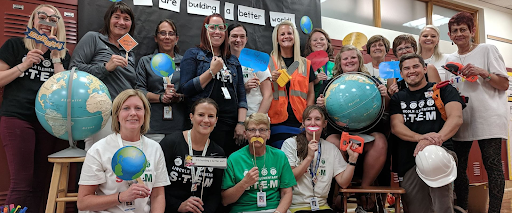 Our teachers are leading the charge with our building administrators right there as well. They have regular team meetings to discuss strategies, implementation of new resources, assessment, opportunities for community projects, and parent involvement in things like maintaining gardens and maker spaces. Our elementary and secondary teachers also have vertical meetings to discuss pedagogy by and large. These meetings have somewhat fallen off in the pandemic, but it's been a staple in the program's growth. Teachers do have ongoing, daily collaborative planning time daily for a period.
Our teachers are leading the charge with our building administrators right there as well. They have regular team meetings to discuss strategies, implementation of new resources, assessment, opportunities for community projects, and parent involvement in things like maintaining gardens and maker spaces. Our elementary and secondary teachers also have vertical meetings to discuss pedagogy by and large. These meetings have somewhat fallen off in the pandemic, but it's been a staple in the program's growth. Teachers do have ongoing, daily collaborative planning time daily for a period.
The administrative role is listening to what teachers need, not necessarily having answers, but taking away barriers that exist in front of them. How can we take away barriers to get that to happen? Teachers are suggesting that they need more training in integrated STEM teaching in particular, so as administrators, how can we take away the barriers to get that training?
How will the STEM program be evaluated?
We are always examining our elements of culture to ensure that we are what we say we are. There are typical measure like STAR and Forward scores and more qualitative measures such as parent surveys, listening sessions, and the assessment tool that I shared with you last week. The assessment tool is part of building staff meetings that's discussed 3 times per year with the rating process as part of the discussions. The examination of STAR scores generally centers on conversations about whether students maintained or advanced in their percentile rank vis a vis their age-based peers. This of course is to determine whether gains have been made in literacy and math primarily and offers a sense of "validation" for lack of a better word, that growth in skills and performance can be witnessed without typical scholastic structures in place like content silos and seat time. Students do a lot of writing as well, so when STEM education comes to mind, these areas typically aren't always highlighted in promotional information, but very much anchor the student experience. Again, if agency is a cornerstone of the culture, then kids engaging in writing and reading about real world interests - help produce authentic artifacts and outcomes...or kids pursue them because they're fun and interesting.
Thinking of reflecting on our work, we have some feedback on the DPI STEM Self-Reflection Tool.
 The reflection tool has some strong indicators of what progress looks like along the Initial – Developing – Systemic range. That’s great as it offers a clear sense of how each category is defined. Greater reflection might occur if there was a goal statement about what established (or Systemic) Vision/Goals, Evaluation of Systems…, Sustainable Funding…etc. looks like and have the teachers/teams discuss and cite examples of where they fall within a range (i.e. initial to systemic) and why. It would be during this process that they might cite things like Community Advisory Committees (or something else), funding streams, equipment inventory, etc as evidence of the growth and status of their programs or schools. If we say that STEM programs with a Systemic impact on its school and local community are only those that have paid advisory committees, the discussion could be fairly brief as that’s not a current reality in most/all cases I would suspect AND many teams of teachers/leaders could feel little ability to influence that in any direct way. But if Community Advisory Committees (or some equivalent, like a School Board subcommittee or parent support group) were cited as an indicator of progress then perhaps the seed is planted for work to commence toward this end.
The reflection tool has some strong indicators of what progress looks like along the Initial – Developing – Systemic range. That’s great as it offers a clear sense of how each category is defined. Greater reflection might occur if there was a goal statement about what established (or Systemic) Vision/Goals, Evaluation of Systems…, Sustainable Funding…etc. looks like and have the teachers/teams discuss and cite examples of where they fall within a range (i.e. initial to systemic) and why. It would be during this process that they might cite things like Community Advisory Committees (or something else), funding streams, equipment inventory, etc as evidence of the growth and status of their programs or schools. If we say that STEM programs with a Systemic impact on its school and local community are only those that have paid advisory committees, the discussion could be fairly brief as that’s not a current reality in most/all cases I would suspect AND many teams of teachers/leaders could feel little ability to influence that in any direct way. But if Community Advisory Committees (or some equivalent, like a School Board subcommittee or parent support group) were cited as an indicator of progress then perhaps the seed is planted for work to commence toward this end.
Another thought, and related to remarks above, would be to perhaps dissect the tool into sections suitable for admin leadership to reflect upon (recruitment, budgets) and those that staff would feel positioned to dive into as a matter of typical work (professional learning, instruction and assessment, PLCS, and so forth). Maybe that’s implied. It might also be helpful to avoid references to what is “sufficient” and “adequate” as those can get people stuck in terms of what that means.